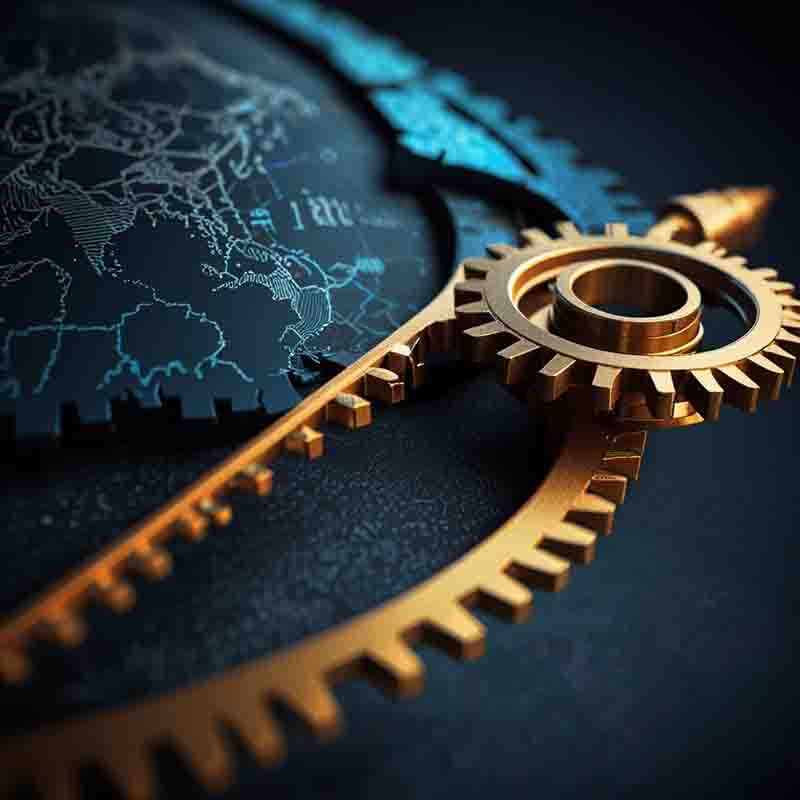The BRICS Effect: The Emerging Market Powerhouse
BRICS+, an alliance of Brazil, Russia, India, China, South Africa, Egypt, Ethiopia, Iran, the United Arab Emirates (UAE), and Indonesia represents influential economies, aiming to reshape global economic, political, and environmental dynamics.

BRICS countries are described as emerging markets, indicating that they are experiencing rapid industrialization and economic growth.
BRICS: New Wave of Global Trade
By promoting equitable development and financial independence, BRICS positions itself as a vital coalition in a rapidly changing global environment, advocating for the needs of emerging economies worldwide.
The coalition operates with the belief that a multipolar world is essential for global stability.
BRICS is significant not only because of its size and population but also due to its economic potential.
The member countries account for a substantial portion of the world's population and landmass, and they are vital players in the international economy.
Their collaboration presents an alternative model to the traditional Western-dominated economic systems.
BRICS emphasizes mutual respect and development that benefits all member nations.
This organization is more than just an economic alliance; it aims to redefine global governance.
The 2024 Summit in Kazan marked the first meeting with new members Egypt, Ethiopia, Iran, and the UAE, addressing expansion strategies and deepening collaboration on sustainable economic growth and stability.
The 17th BRICS Summit took place on July 6–7, 2025, in Rio de Janeiro, Brazil, with the Museum of Modern Art (MAM) serving as the primary venue.
For the detailed BRICS Cooperation glossary please refer to the BRICS cheat-sheet
The acronym BRICS has become synonymous with emerging economies collaborating on various economic, political, and social fronts.
12 Facts To Know About BRICS
-
Member Countries: Initially formed by Brazil, Russia, India, China, and South Africa, BRICS expanded in 2024 to include Egypt, Ethiopia, Iran, and the United Arab Emirates (UAE), broadening its influence across Asia, Africa, and the Middle East. (Saudi Arabia has accepted the invitation to become a member, but has not yet officially joined.) On 7 January 2025, Indonesia becomes a full member.
-
Formation: The BRIC group including the founding countries of Brazil, Russia, India, and China was formally established in 2006. The acronym BRIC was changed to BRICS in 2010 when South Africa joined the group. Since the Kazan Summit, the assosciation is also known as BRICS+.
-
Purpose: BRICS aims to foster economic, political, and cultural cooperation among major emerging markets, representing a significant portion of the global population and GDP.
-
New Development Bank (NDB): Founded in 2014, the NDB funds sustainable infrastructure projects across member countries, aiming to provide an alternative to Western-dominated financial institutions like the IMF and World Bank.
-
Currency and Financial Independence: BRICS nations have discussed creating a common currency to facilitate trade and reduce reliance on the US dollar, signaling a potential shift in global financial dynamics.
-
Trade and Economic Growth: The alliance promotes trade among member states by lowering barriers and increasing cross-border investments, strengthening economic growth and independence for each country.
-
Geopolitical Influence: BRICS supports a multipolar world order, advocating for equitable representation in international organizations and serving as a counterbalance to Western alliances like the G7.
-
Sustainable Development Goals: Environmental and energy cooperation are core BRICS objectives, with projects focusing on renewable energy, biodiversity preservation, and carbon reduction to mitigate climate change.
-
BRICS Network University: This program enhances collaboration in higher education, research, and innovation among member countries, focusing on technology, public policy, and sustainable development.
-
Peace and Security: BRICS prioritizes cooperation on global security issues, including counter-terrorism, cybersecurity, and regional stability, aiming for collective responses to emerging threats.
-
Cultural Exchange: Through events and programs, BRICS promotes cultural diplomacy, facilitating understanding among diverse cultures and strengthening people-to-people connections across continents.
-
Future Expansion and Influence: The addition of new members reflects BRICS’s intent to expand its global reach, inviting countries that share similar values in sovereignty, development, and equitable participation in the international system.
BRICS+ refers to the expanded version of the BRICS group, which now includes additional countries beyond the original five members.
BRICS Partner Countries
Eight countries have accepted partner status (Belarus, Bolivia, Cuba, Kazakhstan, Malaysia, Thailand, Uganda, Uzbekistan, Nigeria, and Vietnam).
Four nations are considering partnership (Algeria, Turkey), while Saudi Arabia's full membership remains pending.
BRICS's Dominance in Critical Sectors
-
Food Production: The BRICS+ are leading producers of essential crops like sugar, maize, rice, wheat, and key meat sources (chicken, pork, beef).
-
Energy: BRICS countries are major players in oil and natural gas production, with half of the top 10 oil producers being BRICS+ members.
-
Green Energy: China's unparalleled leadership in renewable energy investments and manufacturing significantly strengthens BRICS's position in the global green transition.
-
Critical Minerals: The BRICS+ nations are significant producers of critical minerals like, Rare Earth Elements (REEs), Platinum Group Metals (PGMs), Copper, Nickel, Lithium, and iron ore.
BRICS+ boasts major producers of crucial commodities like oil (Russia, China, Iran, UAE, Brazil), food (China, India, Brazil, Russia), and minerals (Brazil, China, India, Russia, South Africa, Indonesia).
BRICS: Timeline
Over the years, BRICS has expanded its influence, establishing the New Development Bank and the Contingent Reserve Arrangement to support member nations in times of economic distress.
The group has held annual summits to discuss various global issues, such as trade, security, and sustainable development.
| Year | Milestone |
|---|---|
| 2001 | Economist Jim O'Neill coins the term BRIC (Brazil, Russia, India, China) in a report, identifying these nations as emerging economic powers. |
| 2006 | The first BRIC summit is held in Saint Petersburg, Russia, where the leaders of Brazil, Russia, India, and China meet for the first time. |
| 2009 | The first official BRIC Summit takes place in Yekaterinburg, Russia, focusing on economic cooperation and global governance reforms. |
| 2010 | South Africa is invited to join the group, expanding BRIC to BRICS. The first summit with all five nations occurs in Sanya, China. |
| 2011 | The 3rd BRICS Summit is held in Durbam, South Africa, emphasizing the need for a multipolar world and stronger economic ties. |
| 2012 | The 4th BRICS Summit takes place in New Delhi, India, focusing on global financial stability and development challenges. |
| 2013 | The 5th BRICS Summit occurs in Durban, South Africa, where leaders discuss the establishment of the New Development Bank (NDB). |
| 2014 | BRICS leaders sign the BRICS Contingent Reserve Arrangement (CRA) during the 6th Summit in Fortaleza, Brazil to provide financial support in times of crisis. |
| 2015 | The 7th BRICS Summit is held in Ufa, Russia, further strengthening economic cooperation and establishing the BRICS Business Council. |
| 2016 | The 8th BRICS Summit takes place in Goa, India, with an emphasis on counter-terrorism and sustainable development. |
| 2017 | The 9th BRICS Summit is held in Xiamen, China, where leaders reaffirm their commitment to reforming global governance and enhancing trade relations. |
| 2018 | The 10th BRICS Summit occurs in Johannesburg, South Africa, focusing on industrialization, innovation, and digital economy. |
| 2019 | The 11th BRICS Summit is held in Brazilia, Brazil, with discussions centered on global security and economic development. |
| 2020 | The 12th BRICS Summit is conducted virtually, emphasizing cooperation in healthcare and vaccine distribution. |
| 2021 | The 13th BRICS Summit takes place in New Delhi, India, focusing on combating terrorism, health security, and sustainable development. |
| 2022 | The 14th BRICS Summit is held in Beijing, China, where leaders discuss the expansion of BRICS and the need for collective responses to global challenges. |
| 2023 | The 15th BRICS Summit is conducted in Johannesburg, South Africa, where six countries, Argentina, Egypt, Ethiopia, Iran, Saudi Arabia, and the UAE, are invited to join. |
| 2023 | Argentinian President Javier Milei withdraws the country from its planned membership of the growing BRICS club. |
| 2024 | The 16th BRICS+ meeting takes place in Kazan, Russia. This summit emphasizes economic cooperation, expansion strategies, and the future direction of BRICS+ with the newly inducted member countries. |
| 2025 | Brazil, the current president of the BRICS, announced the admission of Indonesia as a full member on the 7th of January 2025. |
| 2025 | The 2025 BRICS Summit, held in Rio de Janeiro, Brazil, from July 6 to 7, marked a critical point in the bloc’s development. |
| 2025 | With 11 full members and 10 new partners, BRICS has become the largest bloc of emerging economies, sparking fresh debate over its structure and goals. |
This timeline provides an overview of the significant events in BRICS history, illustrating the evolution of the group and its growing influence on global economic and political dynamics.
Understanding BRICS: A New Path Forward

Since its inception, BRICS has become a vital player in global economics, seeking to provide an alternative to Western-dominated institutions.
The Formation of BRICS
The BRICS grouping initially began as BRIC, with Brazil, Russia, India, and China meeting for the first time in 2006.
South Africa was later invited to join in 2010, leading to the current acronym.
The BRICS have significantly increased their global influence in 2023/2024 and now represent a significant expansion and further development of the original BRICS group.
-
BRICS+: The original five plus Iran, Egypt, Ethiopia, and the United Arab Emirates. On January 7, 2025 Indonesia has officially joined the BRICS+
-
Population: BRICS+ represents about 45-46% of the world's population, up from 41% for the original BRICS.
-
GDP: The group's share of global GDP has increased to about 36-37% from around 25% previously.
-
Trade: BRICS+ accounts for approximately 40% of global trade in goods.
BRICS+ represents a more ambitious and potentially more influential grouping than the original BRICS, but it also faces greater challenges in terms of cohesion and effectiveness due to its expanded and diverse membership.
Understanding BRICS Dynamics
The primary purpose of this alliance is to enhance cooperation among member countries in areas like economic growth, sustainable development, and global governance.
Each member brings unique strengths, enabling them to collaborate effectively.
The formation of BRICS was driven by a common desire to create an alternative to Western-centric institutions like the International Monetary Fund (IMF) and the World Bank.
These institutions have been criticized for imposing policies that favor developed countries.
BRICS aims to empower its members, allowing them to make decisions that reflect their interests rather than those dictated by Western powers.
The group's objectives include promoting peace, security, and development, emphasizing that each country’s sovereignty should be respected.
Key Milestones in BRICS Development
Over the years, BRICS has achieved several milestones that highlight its growing influence.
The establishment of the New Development Bank (NDB) in 2014 was a significant turning point.
This bank aims to finance infrastructure projects in member countries and other developing nations.
It serves as a crucial financial tool that empowers BRICS to promote sustainable development without relying on Western institutions.
Another important moment came during the 15th BRICS summit, held in Johannesburg in August 2023.
This meeting marked the official invitation of new members, including Egypt, Ethiopia, Iran, and the United Arab Emirates.
Their inclusion indicates BRICS's intention to expand its reach and influence, particularly in Africa and the Middle East.
The 2024 summit in Kazan, Russia, has build on this momentum, focusing on cooperation and economic collaboration among the expanded membership.
New Development Bank: Purpose and Impact
The New Development Bank (NDB) plays a crucial role in the BRICS framework.
It was established to fund infrastructure and sustainable development projects in BRICS nations and other emerging economies.
BRICS Currency
BRICS countries have initiated discussions on creating a common currency.
The idea reflects the growing desire for financial autonomy and will lead to significant shifts in global trade patterns and currency markets.
Trade Relations within BRICS and Beyond
Trade relations among BRICS countries have been expanding over the years.
The combined economic power of these nations allows them to engage in substantial trade activities.
Intra-BRICS trade has seen significant growth, with member countries exchanging goods and services in various sectors.
Initiatives like BRICS Plus aim to foster collaboration with other countries in the Global South.
By strengthening ties with these nations, BRICS will create a more balanced global economy that reflects the interests of developing countries.
Multipolarity: BRICS’s Vision
One of BRICS's core principles is the promotion of a multipolar world.
This concept advocates for multiple centers of power in global governance, reducing the dominance of any single country or bloc.
BRICS members argue that a multipolar approach is essential for global stability and peace.
It allows for more equitable representation of various nations in international decision-making.
BRICS actively participates in global governance institutions such as the United Nations (UN) and the World Trade Organization (WTO).
By working together, they amplify their voices and push for reforms that favor developing countries.
Diplomacy and Political Independence
Political independence is a cornerstone of BRICS's philosophy.
Member countries share a commitment to non-interference in each other's domestic affairs.
This principle is vital for maintaining sovereignty and fostering mutual respect among member nations.
The group’s emphasis on political independence enables its members to pursue their unique paths to development.
Each country has different political systems, economic strategies, and cultural backgrounds.
BRICS respects these differences while promoting cooperation on issues of mutual interest.
This inclusive approach creates a strong foundation for long-term partnerships.
Expansion of BRICS
The expansion of BRICS at the Kazan 2024 summit was a pivotal moment for the coalition.
The successful addition of Egypt, Ethiopia, Iran and the United Arab Emirates demonstrated the Group's desire to strengthen its global presence.
Additionally, Indonesia has become a full member on 7th of January 2025.
With new members, BRICS can diversify its economic activities and deepen cooperation in various sectors, including energy, agriculture, and technology.
The expansion also sends a clear message that BRICS is a viable alternative to Western-led initiatives.
As the group continues to grow, its ability to influence global governance and economic policies will only increase.
BRICS and the United Nations’ Sustainable Development Goals (SDGs)
BRICS is committed to aligning its initiatives with the United Nations’ Sustainable Development Goals (SDGs).
These goals aim to address global challenges such as poverty, inequality, and climate change.
By incorporating the SDGs into their policies, BRICS members demonstrate their dedication to sustainable development.
Each BRICS country faces unique challenges regarding sustainable development.
For instance, Brazil must address deforestation in the Amazon, while India grapples with air pollution.
By sharing best practices and resources, BRICS members can learn from each other and make progress toward achieving their SDGs.
Collaboration in this area can enhance their global standing as leaders in sustainable development.
Energy Transition and Climate Policies
Energy transition is a significant focus for BRICS countries.
Each nation is working on strategies to shift toward cleaner energy sources.
This transition is vital for addressing climate change and ensuring long-term energy security.
BRICS countries recognize that cooperation in energy policy can lead to innovative solutions and shared benefits.
BRICS members have initiated several joint projects in renewable energy.
These projects include solar, wind, and hydropower initiatives.
By pooling resources and expertise, BRICS can accelerate the transition to sustainable energy.
This collaborative approach not only benefits member countries but also contributes to global efforts to combat climate change.
Notable Projects in Sustainability
Sustainability projects funded by BRICS are making a positive impact.
These projects range from infrastructure improvements to environmental conservation initiatives.
For example, the NDB has financed several renewable energy projects that focus on reducing carbon emissions and promoting energy efficiency.
In addition, BRICS countries are investing in research and development for green technologies.
This investment is crucial for advancing sustainable practices and promoting innovation.
As BRICS continues to prioritize sustainability, it will position itself as a leader in global environmental efforts.
Internal Challenges Facing BRICS
Despite its successes, BRICS faces several internal challenges.
One significant issue is the economic disparity among member nations.
Countries like China and India are economic powerhouses, while others, like South Africa, struggle with high unemployment and slow growth.
These disparities can create tensions when making collective decisions.
Political differences also present challenges.
Each BRICS country has its political system and governance style.
Navigating these differences while fostering cooperation can be tricky.
However, the commitment to mutual respect and understanding helps address these challenges.
Global Perception and Western Relations
The global perception of BRICS varies. Some view it as a counterbalance to Western dominance, while others criticize it for lacking coherence.
Additionally, relations with Western countries can be complex.
BRICS nations find themselves at odds with many Western policies, particularly regarding trade and diplomacy.
Despite these challenges, BRICS is working to improve its relationships with Western nations.
Engaging in dialogue and finding common ground is crucial.
By doing so, BRICS will strengthen its position on the global stage while remaining true to its principles.
Opportunities for Growth and Influence
BRICS has ample opportunities for growth.
The expanding member base enhances its economic clout.
The growing cooperation among member nations leads to increased trade and investment.
This collaboration presents a chance for collective bargaining power in international markets.
Additionally, BRICS's focus on sustainable development opens new avenues for collaboration.
As global interest in environmental issues rises, BRICS can position itself as a leader in green initiatives.
The potential for growth and influence is immense, and BRICS is well-positioned to capitalize on these opportunities.
Strategic Goals
Looking ahead, BRICS has set strategic goals for the next decade.
These goals focus on enhancing economic cooperation, expanding trade, and deepening political ties among member nations.
The establishment of a BRICS currency remains a topic of discussion, with potential plans in the works.
Another key objective is increasing the influence of the NDB.
By expanding its funding capacity, the NDB can support more projects that drive economic growth and sustainable development.
Member countries aim to collaborate more effectively to achieve these goals.
BRICS as a Leader of the Global South
BRICS seeks to position itself as a leader of the Global South.
By strengthening ties with other emerging markets, BRICS aims to promote equitable development.
This strategy aligns with its mission to advocate for the interests of developing nations in global discussions.
As BRICS expands its membership and influence, it will play a vital role in shaping the future of global governance.
By championing the rights of developing nations, BRICS can ensure a more balanced and fair world order.
The Significance of BRICS
BRICS plays an increasingly vital role in shaping global economic and political landscapes.
As the alliance continues to expand and evolve, it remains committed to promoting cooperation among its members and addressing pressing global challenges.
The future of BRICS looks promising, and its influence on international affairs is likely to grow, particularly as it seeks to represent the voices of developing nations in a rapidly changing world.
-
BRICS Nations: The countries comprising the BRICS bloc, focusing on collaborative strategies to improve their economic and political influence globally.
-
Global Economic Cooperation: Collaborative efforts to address economic challenges, enhance trade relations, and promote sustainable development across borders.
-
Geopolitical Alliances: Strategic partnerships based on mutual interests, often influenced by geographical factors, political objectives, and economic goals.
-
International Trade Agreements: Formal accords to govern trade practices, tariffs, and market access, enhancing economic relations among signatory nations.
-
BRICS Economic Summit: A periodic meeting of BRICS leaders to discuss economic cooperation, development goals, and strategies to enhance trade among member nations.
-
Trade Relations: The economic exchanges, agreements, and interactions regarding the import and export of goods and services.
-
Currency Cooperation: Efforts among BRICS nations to explore alternatives to traditional currencies for trade, including the potential for a BRICS common currency.
-
BRICS Expansion: The process of increasing the number of member countries in BRICS to include new economies, enhancing the group's global influence and economic power.
-
BRICS Summit Agenda: The list of topics and discussions planned for the BRICS summit, including economic policies, international security, and environmental sustainability.
-
BRICS Economic Initiatives: Programs and projects launched by BRICS to promote economic growth, sustainable development, and regional stability.
-
BRICS Geopolitical Impact: The influence and power dynamics shaped by BRICS on the global stage, affecting international relations and economic strategies.
-
Infrastructure Projects in BRICS: Major initiatives aimed at improving transportation, energy, and communication systems within BRICS nations to foster economic growth.
-
Investment Opportunities in BRICS: Potential sectors and industries within BRICS countries where foreign and domestic investors can allocate capital for growth and returns.
-
BRICS Cultural Exchanges: Programs and initiatives promoting mutual understanding and cultural ties among BRICS nations, enhancing people-to-people connections.
BRICS aims to promote peace, security, and development in the member countries and globally through cooperation and mutual benefit.
BRICS: Redrawing the Map of Global Influence
BRICS is an influential alliance that is reshaping the global economic landscape.
Its commitment to cooperation, sustainability, and political independence sets it apart from traditional Western-led initiatives.
As BRICS continues to grow and evolve, it has the potential to become a major force in international affairs.
The future looks promising for BRICS, and its impact on the global economy will likely be felt for years to come.
BRICS: FAQ

Want to Understand BRICS?
Join a community of informed citizens and engage with insightful content.
Stay in the LoopPartnering for Prosperity
The Magic of Tatarstan
